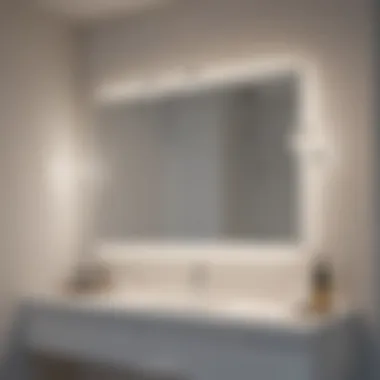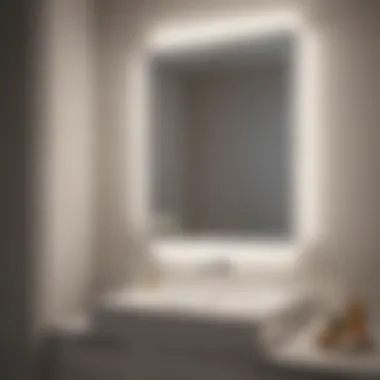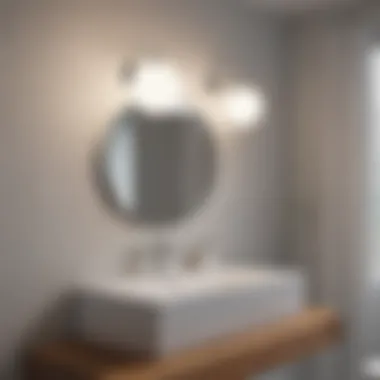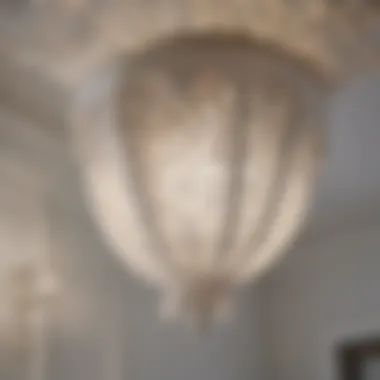Essential Guide to White Bathroom Light Fixtures


Intro
In the realm of bathroom design, lighting plays a pivotal role. It’s more than just a functional necessity; it can transform the atmosphere, enhancing both aesthetics and comfort. White bathroom light fixtures, in particular, have gained popularity for their versatility and ability to create a bright, inviting space. Homeowners and design enthusiasts alike often overlook these elements, yet they are crucial in defining the look and feel of a bathroom.
Choosing the right lighting can make all the difference, whether you're embarking on a total renovation or just updating your light fixtures. This guide aims to delve deeply into the world of white bathroom lighting, examining different styles, color palettes, and practical tips to elevate your bathroom environment. From modern minimalism to cozy rustic touches, there's a white fixture that fits your needs and personal style. Understanding the various factors at play will empower you to make informed decisions, ensuring that your bathroom lighting complements your overall design vision.
Embarking on this journey, you will uncover the significance of style, how color impacts your space, and the installation nuances that can often trip up even the savviest DIY-ers. So, buckle up as we lead you through the bright and fascinating world of white bathroom light fixtures.
Prelude to Bathroom Lighting
When we talk about bathroom lighting, it’s easy to overlook its significance. The truth is, lighting can make or break the feel of a bathroom. Good lighting not only enhances aesthetics but also addresses practical needs—making it essential for homeowners. Particularly, with the increasing trend of turning bathrooms into personal sanctuaries, proper lighting has become more relevant than ever.
Importance of Lighting in Bathrooms
Lighting is vitally important because it serves multiple functions—from illuminating spaces for grooming to creating an inviting atmosphere. A well-lit bathroom helps in performing daily tasks, like shaving or makeup application, where shadows can be a major nuisance. The way light interacts with colors and textures also plays a role in influencing mood.
Moreover, the energy efficiency of lighting options has seen improvements, making it easier for homeowners to choose sustainable solutions. It’s not just about visibility; it’s about setting the right tone for a space that often serves as a small retreat from the chaos of everyday life.
- Visibility: Proper lighting is essential for safety and functionality.
- Mood Enhancement: Lighting can evoke feelings of tranquility or energy, depending on what you want.
- Energy Efficiency: Modern lighting options save on power bills while keeping the space bright.
Role of Fixtures in Creating Ambiance
When fixtures are thoughtfully chosen, they don’t just serve to light up a space; they can transform the entire environment. Different types of fixtures complement various styles, ensuring that the bathroom’s aesthetic is cohesive with the rest of your home.
A well-placed pendant light can provide a focal point, while wall-mounted sconces can deliver soft, diffused illumination that helps in relaxation. Each fixture has its own purpose, and understanding these roles can significantly enhance the overall ambiance.
- Task Fixtures: These are designed for utility. Think vanity lights that ensure no shadows when grooming.
- Decorative Fixtures: These enhance the design and add character, like trendy chandeliers.
- Ambient Fixtures: They create a warm backdrop and make the space feel comfortable.
" Lighting is not just about illumination; it’s about weaving together utility and artistry."
Choosing the right fixtures isn’t just about aesthetics; it’s about enhancing functionality and elevating the bathroom experience. Questions around brightness, color, and style should guide the choice of bathroom lighting, ensuring that the fixtures address both practical and emotional needs. Whether envisioning a minimalistic setting or a lavish retreat, every homeowner should consider how these elements come together to create a genuinely harmonious bathroom atmosphere.
Understanding White Bathroom Light Fixtures
When it comes to illuminating any space, particularly the bathroom, the importance of selecting the right fixtures cannot be overstated. White bathroom light fixtures offer a versatility and timelessness that fits various design aesthetics while enhancing functionality. Understanding these fixtures is essential for homeowners looking to create an inviting atmosphere and ensure adequate lighting for daily routines.
Definition and Characteristics
White bathroom light fixtures are defined by their primary use of white shades or finishes, which reflect and diffuse light well. The beauty of white fixtures is not just in their appearance; they play a significant role in how a bathroom feels. Clean and modern, they often help in making smaller spaces appear larger while maintaining a fresh ambiance.
Additionally, many have characteristics like adjustable brightness or integrated energy-efficient technologies, ensuring they meet both aesthetic and pragmatic needs. A well-chosen white fixture can become a focal point of the room or blend seamlessly into the background, depending on design goals.
Types of White Fixtures
Choosing the right fixture involves understanding the various types that are available. From wall-mounted to pendant lights, each serves a unique purpose in contributing to the overall illumination and design of a bathroom.
Wall-mounted Fixtures
Wall-mounted fixtures often serve dual roles, providing task lighting while also adding an element of decor. One key characteristic is that they can be installed at various heights, allowing for customization based on user needs. Popular for their ability to create a soft glow around mirrors, these fixtures enhance visibility while still retaining that cozy feel.
The unique feature of wall-mounted fixtures is their adaptability; they can work in tight spaces where ceiling lights might not fit well. However, it's important to consider their placement, as improper installation could lead to shadows on the face, making activities like shaving or applying makeup tricky.


Ceiling-mounted Fixtures
Ceiling-mounted fixtures are often the workhorses of bathroom lighting. These lights offer widespread illumination and are typically designed with a minimalistic aesthetic to blend into the background. The key here is that they provide uniform lighting, ensuring every corner of the bathroom is well-lit, which is especially beneficial in larger spaces.
Their unique feature is the ease of installation, making them a go-to choice for homeowners looking for a hassle-free option. However, depending on the type chosen, some designs might require higher ceilings to avoid feeling cramped or cluttered.
Vanity Lights
Vanity lights, typically installed around mirrors, are critical for functionality and elegance. One crucial aspect is that they provide focused lighting, which is ideal for grooming tasks. Many homeowners find vanity lights particularly appealing due to their ability to add style and drama to the bathroom.
These fixtures often come in various designs, from sleek modern to vintage. Their unique advantage is that they can enhance both the practical aspect of daily routines while also serving as artistic accents. But, like wall-mounted fixtures, improper placement can lead to shadows, making it essential to consider how they will be arranged creatively.
Pendant Lights
Pendant lights bring a touch of flair to bathroom design. They hang from the ceiling, usually at eye level, which allows them to serve as both light sources and décor elements. The key characteristic is their ability to focus light downward, creating a warm and inviting atmosphere that’s great for relaxation or entertaining.
Their unique feature is the variety of styles; they can be sleek and modern or rustic and warm, fitting almost any design sensibility. However, they do need to be installed at a proper height to avoid obstructing views or making the space feel cramped.
Design Considerations for White Bathroom Light Fixtures
Designing a bathroom goes beyond just picking tiles and paint colors; lighting plays a crucial role in establishing the overall feel of the space. For homeowners and design enthusiasts considering white bathroom light fixtures, understanding the various design considerations is key. Proper lighting can illuminate different areas effectively, helping to create a sanctuary that feels both functional and inviting.
When it comes to white fixtures, several elements need attention: the shade of white, the compatibility with existing decor styles, and the intended use of the lighting within the space. It's essential to select fixtures that not only look good but also serve the practical purpose of making the bathroom a comfortable, stylish environment.
Choosing the Right Shade of White
Picking the right shade of white can significantly impact the ambience of the bathroom. White is not just one-dimensional; it has various shades, each offering a unique feel. From warm whites with yellow undertones to cool whites with blue hints, the choice can create a different mood.
- Warm White: This shade creates a cozy, inviting atmosphere, making it ideal for bathrooms that invoke a spa-like feeling. Think about using warm white lights for a more relaxing environment.
- Cool White: This shade leans towards modernity. It gives a crisp, clean look that can make a bathroom feel more open and bright. Perfect for minimalistic designs, it enhances the sense of space.
Choosing the right shade is crucial not just for aesthetics, but also for how light affects the perception of space and cleanliness.
Style and Theme Integration
Modern Minimalism
Modern minimalism is characterized by sleek lines and an uncluttered aesthetic. In a bathroom setting, this style champions functionality without sacrificing beauty. The use of white bathroom light fixtures within this theme revolves around simplicity and utility.
A key characteristic of modern minimalism is the focus on natural light, with white fixtures enhancing daylight. Fixtures can often blend into the background, allowing other design elements like mirrors or artwork to stand out. One of the unique features of a minimalistic approach is the use of hidden or recessed lighting which maintains the clean lines so coveted in modern designs. While the minimalist design is generally beneficial as it keeps spaces airy, a common disadvantage could be that it might lack warmth unless carefully curated with texture and accents.
Traditional Elegance
Traditional elegance brings a touch of classic aesthetic into bathroom designs. This style embraces ornate details and luxurious materials. The choice of white fixtures in this context often includes softer shapes and decorative elements that echo traditional designs.
A notable feature is the use of fixtures that may showcase a certain craftsmanship, like a porcelain finish or vintage design elements. Such traits enhance the overall luxurious feel of the bathroom. This style is popular for those wishing to convey sophistication and charm; however, it can sometimes be less flexible in integrating modern touches, potentially appearing outdated over time.
Industrial Chic
Industrial chic is a style that stands as a celebration of raw materials and unfinished looks, making it quite unique and interesting in lighting design for bathrooms. White fixtures in this style often juxtapose harsh industrial elements with softer white tones. Think about using fixtures that contrast with exposed bricks or pipes; this creates an exciting visual narrative.
The rugged yet refined appearance of industrial design allows for adaptability. Key features often include metallic finishes paired with soft white light, enhancing both character and functionality. A downside could be that the stark contrasts in design might not appeal to everyone, particularly those who prefer more traditional looks.


In summary, selecting the right design considerations for white bathroom light fixtures involves a careful balance between aesthetics and functionality. Each design style carries its own unique set of advantages and challenges, guiding homeowners to create a space that truly reflects their personal taste.
Functional Aspects of Lighting
Understanding the functional aspects of lighting in bathrooms is crucial for homeowners and designers aiming to create a space that's both beautiful and practical. Lighting not only sets the mood, but it also enhances the usability of the space. Having the right lighting in your bathroom can transform it from a utilitarian area to a serene sanctuary. When discussing lighting, two specific categories come to mind: task lighting and ambient lighting. Each plays an essential role in improving functionality.
Task Lighting vs. Ambient Lighting
Task lighting is all about functionality. Think of it as your spotlight for completing specific activities. In the bathroom, this means bright lights around the vanity area for grooming tasks like shaving or applying makeup. Without sufficient task lighting, these everyday activities can become a guessing game, which is less than ideal when precision is key.
On the other hand, ambient lighting serves as the overall glow of the space. It's the type of lighting that helps you feel comfortable and relaxed while moving about the room. Think of soft, warm lights that gently illuminate the space without overwhelming your senses.
To strike the right balance, it is wise to incorporate both types of lighting:
- Task Lighting: Focused areas, such as vanity lights or wall sconces.
- Ambient Lighting: Well-placed ceiling fixtures or recessed lights that provide a soft wash of light throughout the entire room.
By thoughtfully combining these two types, you achieve a well-rounded lighting scheme that caters to your practical needs while also inviting comfort.
Importance of Color Temperature
Another crucial consideration in bathroom lighting is color temperature, which can dramatically affect both mood and functionality. Color temperature refers to the warmth or coolness of light, usually measured in Kelvin (K). Understanding how to select the right color temperature is essential to creating your desired bathroom atmosphere.
A warmer color temperature, around 2700K to 3000K, can evoke feelings of coziness, making your bathroom feel more like a retreat. However, for tasks that require precision, like applying makeup or shaving, a cooler color temperature, around 4000K to 5000K, can help reveal colors correctly. This cooler range mimics natural daylight, giving feelings of alertness and focus.
"The right color temperature can make your bathroom feel like a different space altogether; it's about choice and effect."
To illustrate:
- Warm Light (2700K - 3000K): Ideal for creating a relaxing environment.
- Natural Light (4000K - 5000K): Best for practical grooming tasks.
To sum up, understanding the functional aspects of lighting is essential for designing an effective bathroom. By integrating both task and ambient lighting along with selecting the appropriate color temperature, you can ensure that your bathroom serves its purpose while also providing a peaceful retreat.
Installation and Maintenance of White Light Fixtures
Bathroom lighting isn’t just a mere afterthought; it's essential in making a space not only livable but inviting. The act of installing and maintaining white light fixtures can significantly influence both functionality and aesthetics. If lights aren't installed properly, it might lead to frustrating dark corners or glaring spots that detract from the atmosphere you aim to create. Additionally, the maintenance of these fixtures plays a critical role in their longevity and performance.
White light fixtures can brighten even the gloomiest bathrooms and they're quite versatile, fitting into various design themes like sleek modern or quaint traditional. Understanding how to install and care for them can prevent unnecessary costs down the road, ensuring your efforts to elevate your bathroom aesthetics are well-supported.
DIY Installation Tips
For the brave and handy, installing light fixtures yourself can save a pretty penny. Here are a few nuts and bolts of DIY installation:
- Safety First: Always switch off the circuit breaker before starting. Check the wiring, because a shock isn’t just hair-raising—it’s potentially lethal.
- Read the Instructions: It might take a little time to understand, but reading the manufacturer’s guide reduces mistakes. Every fixture can have its quirks.
- Gather Tools in Advance: Common tools include screwdrivers, a wire cutter, and a voltage tester. Having everything at hand minimizes those dreaded trips up and down the ladder.
When tackling installation, consider enlisting a friend. It’s easier and safer, particularly if you're working at heights. Know your own limits.
Maintenance Best Practices
Keeping your white light fixtures in tip-top shape means scheduling regular maintenance. Here are some practical habits to adopt:
Cleaning Techniques


Dust and grime can accumulate on light fixtures, causing them to perform poorly.
- Gentle Approach: Always opt for a soft cloth or microfiber towel for cleaning. Avoid using coarse materials that might scratch any glossy surfaces.
- Mild Soap Solution: A mixture of warm water and a mild soap can do wonders. Dip your cloth in the solution, wring it out, and gently wipe down the light. This way, it won’t drip everywhere.
- Frequent Checks: It’s beneficial to set a cleaning schedule, maybe once a month. This commitment prevents buildup and keeps lights bright and inviting.
"A little regular care goes a long way. It’s cheaper than replacing fixtures down the line."
Bulb Replacement Guidelines
Uh-oh, the moment when your fixture flickers. Bulb replacement is a straightforward process, salvage those nerves:
- Know Your Bulb Type: Different fixtures take different bulbs—incandescent, LED, or compact fluorescent. Always check the box for recommendations.
- Turn Off Power: Just like with installation, switching off power is mandatory here. Safety shouldn’t be skipped.
- Careful Handle: Don’t grab bulbs with bare hands if they are halogen. Oil can leave residue that leads to early burnout. Use a cloth or gloves.
Being familiar with these practices ensures your white bathroom light fixtures shine brightly and last long. It’s about building a routine that protects your investment, enhancing your bathroom’s overall setup.
Trends Influencing White Bathroom Light Designs
Staying in tune with trends is vital for any stylistic endeavor, particularly in the realm of interior design. When it comes to white bathroom light fixtures, understanding the current trends influences not only aesthetics but also functionality and energy efficiency. Homeowners often find themselves navigating a myriad of options, and keeping an eye on the latest styles and innovations can make decision-making far less daunting. To ensure that your bathroom doesn’t just meet the functional needs but also resonates with contemporary design, let’s delve into two pivotal trends: sustainable design practices and innovations in smart lighting.
Sustainable Design Trends
Sustainable design isn’t merely a buzzword; it represents a paradigm shift in how we think about our environments. White bathroom fixtures crafted with eco-friendly materials not only reduce carbon footprints but also contribute to a sense of serenity and purity in the space. Consider the following elements:
- Materials: Look out for fixtures made from recycled metals, low-VOC finishes, or sustainably sourced wood. These options not only elevate the aesthetics with a unique texture but also signal a commitment to environmental well-being.
- Energy Efficiency: Fixtures that incorporate LED technology consume less energy and last longer than traditional incandescent bulbs. Choosing fixtures that are energy-star rated indicates that you're not just lighting your space but doing so with sustainability in mind.
- Water-Saving Features: Pairing lights with water-saving faucets and shower systems can further enhance sustainability. This holistic approach is about more than just lighting; it’s about creating a bathroom that embodies eco-conscious living.
As more homeowners become increasingly aware of their ecological impact, the demand for sustainable designs is anticipated to grow. It’s a trend that does not seem to be fading anytime soon, redefining rooms into calming, sustainable sanctuaries folks can feel good about.
Smart Lighting Innovations
The advent of smart home technology has dramatically transformed the landscape of lighting design. When considering white bathroom light fixtures, integrating smart technology opens a treasure trove of possibilities. Some significant aspects to examine include:
- Customization: Smart fixtures allow homeowners to customize the light’s intensity and color temperature according to their needs or moods. For instance, adjusting the warmth of the light can create a relaxed atmosphere for bathing, while brighter settings are perfect for activities like makeup application.
- Control Systems: Many smart lighting systems can be controlled through smartphones or voice-activated devices. This offers convenience and the ability to adjust settings without having to flip a switch or walk into the room. Imagine being able to dim the lights as you unwind after a long day, all with just a command.
- Integration with Other Systems: Smart lighting can be seamlessly integrated into larger home systems, working in tandem with heating and security features. As your bathroom lights respond to your presence, they can play a role in overall security, ensuring the room is illuminated when you enter.
"Smart lighting isn't just a feature; it’s a lifestyle upgrade that can contribute to your well-being and streamline daily activities."
Overall, these trends reflect the evolving nature of bathroom design. Embracing sustainable practices and smart innovations not only enhances the appearance of your white bathroom fixtures but also aligns with a lifestyle that prioritizes efficiency and elegance.
Budgeting for Bathroom Lighting
When embarking on a bathroom lighting project, budgeting becomes more than a mere number-crunching exercise; it’s about ensuring that your vision aligns with financial reality. Proper budgeting for bathroom lighting can make a substantial difference between a drab space and a dazzling sanctuary. It’s essential to consider not only the initial costs but also long-term expenses associated with maintenance and repairs.
Summary and Epilogue
In wrapping up our exploration of white bathroom light fixtures, it's pivotal to reflect on the significance of this topic. Lighting, often an underappreciated detail in bathroom design, plays a crucial role in setting the overall mood and function of these spaces. Whether it’s a gentle glow for relaxation or bright illumination for morning routines, the right approach to lighting can transform a drab bathroom into a serene sanctuary.
Recap of Key Insights
As we've journeyed through various aspects of white bathroom lighting, a few key insights stand out:
- Importance of Color Temperature: The temperature of light can change how a bathroom feels. Warm whites create a cozy ambiance, while cool whites offer clarity for grooming tasks.
- Design Integration: Selecting fixtures that align with your home’s design theme ensures a cohesive look. Whether modern or traditional, there’s a suitable white fixture for every style.
- Budgeting Wisely: Balancing quality and cost is vital. You can find elegant fixtures that don't break the bank, but be cautious—sometimes, spending a bit more pays off in durability and aesthetics.
"Good lighting is like a fine wine; it brings warmth and character to the place, even if it’s just a bathroom."
Future Perspectives in Bathroom Lighting
Looking ahead, the future of bathroom lighting is bright—and I mean that quite literally. With advancements in technology, several trends are shaping how we perceive lighting in these personal spaces:
- Smart Lighting Solutions: The rise of smart home technology is paving the way for dynamic lighting options. Imagine adjusting your bathroom lights through an app or voice command to suit your mood or task. This interactive approach fosters a personalized experience right in your own home.
- Sustainable Designs: Eco-friendly materials and energy-efficient LEDs are rapidly becoming the industry standard. Homeowners are increasingly aware of their environmental footprint, leading to a greater demand for sustainable choices without compromising style.
- Layered Lighting Concepts: The practice of using multiple sources of light—task, accent, and ambient—is gaining traction. A stratified approach means you can create various atmospheres in one room while enhancing functionality.















